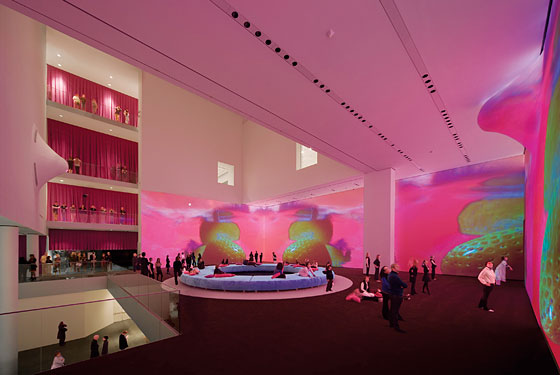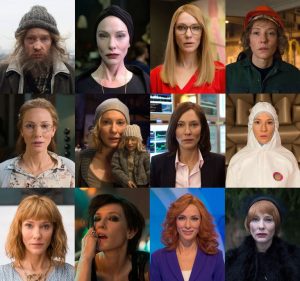
Breaking down the trichotomy between video art, artists’ films, and cinema
In the world of moving image and film almost any artistic product is categorized into one of three groups: traditional cinema, artists’ film (or avant garde/experimental film), and visual art. To use the traditional definitions: cinema is seen as something that is more story and actor focused and is expected to reach a wider audience for commercial profit, artists’ films favor aesthetic or artistic vision or experimental methods over commercial profit, and video art is concerned solely with discovering and manipulating the medium of moving images themselves. These three separate definitions dictate the manner in which artists see themselves, how and which critics and audiences view works, and in what way the work is (or is not) commodified after its creation. By willingly adhering to this trichotomy, the intellectual community upholds a limiting and elitist status-quo of the modern art world, making it clear that these definitions are superficially constructed. This construction, instead of legitimizing film as a medium, inhibits a level of creativity and authenticity that could liberate not only all film- and video-makers as a whole, but also provide audiences with more complex, fulfilling experiences without narrowing the range of current distribution models.
While there are many notable successful works of video art and film that transcend content or distribution boundaries, critics and academics still describe and analyze filmic art by dividing it into visual art, artists’ cinema, or traditional cinema. Brooklyn Rail, an independent arts journal, for example, released a 2014 issue that featured 17 articles on the topics of artists’ cinema and video art. Most of these were critical of the comparison of the two, including (an article by) Roger Beebe, a filmmaker, who began by saying, “I was asked to write about the present and future of ‘artists’ cinema’ and ‘moving-image art.’ This language conflates two traditions that I still have a stake in separating: experimental film and (gallery/museum) video art.” As this quote clearly highlights, not only do many of the critics from this issue actively describe differences in creative, technical, and distribution techniques as one might expect, they also speak with a language that subtly reveals the level of competitiveness that these discussions seem to follow – everyone always has a “stake” in separating the mediums of film. Similarly, there is an equal and growing push that pulling avant garde and ‘artists’ cinema’ away from mainstream cinema. Aesthetica’s David Gleeson nailed this split by stating “just like Hollywood’s two biggest industries – cinema and porn – the gulf between artists’ films and popular cinema is apparently quite vast, and it is often assumed that both will never meet on common ground.” These articles show that critics and makers alike have a perception that film mediums must be stringently categorized into one of three pillars.
While these divisions remain strong and (often) unchallenged in the film world, there are a number of examples that reveal both the negative impacts of these didvisions, as well as the positive outcomes when these categorizations are transcended. Looking at two specific examples, a MoMA video installation and an avant garde film shown at a film festival, reveals a number of points about audience reception, engagement, and general effect. The first, Pour Your Body Out (Pipilotti Rist, 2008) turned the Museum of Modern Art in New York’s atrium room essentially into a womb. It utilized video projections depicting and fetishizing innuendos of fertility (for example, a woman filling someone else’s mouth with flower petals). These projections were on a 16 minute loop and covered the walls – altering the atmosphere of the entire room. Museum patrons were allowed to use the space as they pleased, including one afternoon when yoga was held in it. The audience ranged from video art experts to couples lounging on the couches to overwhelmed parents that needed a space for their children to safely wander. Pour Your Body Out provided a clear example of a space that was meant to be inhabited and lingered in, providing enough space and movement for the work to be seen from different perspectives and to be processed at a viewer’s own pace.
When comparing Rist’s video installation to a screening of the avant garde film The Foundation of the Wheel (Richard Tuohy, 2015) at the Edinburgh International Film Festival a few things are notable. A 14 minute piece flashing between two inverse images of a wheel at varying speeds, The Foundation of the Wheel was shown in one of the smallest theaters at the festival only twice, and was predominantly viewed by people already familiar with and appreciative of avant garde filmmaking. In an effort to avoid commodification as gallery art and stay true to the medium of avant garde film, Tuohy chose to show it in a traditional cinema, even though this undercut its ability to reach new, wider audiences. It was a perceptual film, that in an effort to elicit a sensory response, resulted in most of the small viewership to either fall asleep or walk out of the theater. Shown in a different platform, however, could have enabled people to come in and out of the experience and actively try to experience it. Pour Your Body Out not only was able to reach wider audiences, it was also able to engage them more. If The Foundation of the Wheel had been less decidedly avant garde, it could have benefitted from a similar effect.

http://www.independentcinemaoffice.org.uk/films/he-who-laughs-last?ami=1&c=5012#
In her essay, Exhibiting Cinema in Contemporary Art (2013), Erika Balsom writes about the exhibit Pour Your Body Out noting, “[it] indicate[s] the extent to which the contemporary integration of cinema into the museum must be seen not only as a matter of protecting or commemorating an endangered institution, but also of mobilizing its accessibility and entertainment values in order to attract audiences.” The positive side to disregarding conventional categorizations of film, however, lies not only about audience expansion. In many cases, by challenging the type of art film, the art itself transcends these critical divides and able to becomes something more insightful. An early example comes out of the seventies with Chris Burden’s Self Paid Adverts that aired on broadcast television. Blurring the line between television, commercials, film, and video art Burden made larger statements about what art and film could be and how it could be viewed.
Similarly, He Who Laughs The Longest (Phil Collins, 2006) was an avant garde film about a laughing contest that was aired in some UK cinemas (with much success) before showings of Borat (Larry Charles, 2016) as part of the “Artists Cinema” project, an effort promoted by the Independent Cinema Office and LUX. Here David Gleeson’s article helps frame how the “subversion” of the distribution method can add to a piece, in direct response to He Who Laughs The Longest showing before Borat, he says “th[ese] … pairings prove that the space between mainstream cinema and artists’ film is not necessarily insurmountable. A surprising phenomenon is the difference of seeing an artists’ film in a cinema rather than a gallery context.” By allowing an experimental film to be shown to audiences in a different way, Collins enabled people to consume the piece with a different mindset that allowed them to process it. These two examples show how showing an audience with an unexpected medium can have its advantages and lead to just the response that the artist is looking for.

http://www.julianrosefeldtinberlin.de/index.php?id=2367
In an inverse manifestation, galleries are beginning to utilize video installations that seem more like short films. In the recent gallery exhibition from Manifesto (Julian Rosefeldt, 2014) museum goers are encouraged to walk about or sit in a darkened room as they watch different 10 minute projections on 13 different screens that all play simultaneously. Each projection features actress Cate Blanchett embodying a different character in a different setting as she recites monologues based off of famous manifestos. While each projection could be exhibited individually as short films or all 13 in succession as a longer art film, Rosefeldt amplifies each individual manifesto by having them all play at the same time, in the same space together. He correctly assessed the viewing method that would add to the work, instead of restricting himself to convention. The films become orchestral together and play off one another. Also notable, most viewers sat and watched each projection in its entirety before moving on to the next, undermining assumptions that short view times in traditional galleries (studies cite just under 30 seconds as the average time viewers look at a painting) apply to video installations – a key point from film-makers against placing their (typically longer than 30 second) films into a gallery. To date few studies has examined the viewing time in video installations themselves. In stark contrast to Manifesto, Homo Sapiens (Nikolaus Geyrhalter, 2016) is a 94 minute long film showing still frames of empty spaces that is being marketed as a feature film. Homo Sapiens could benefit from some more consideration about ideal viewing methods and potentially by using a model more similar to Manifesto could have captivated viewers to think about the film more critically and collectively. In its current state, it is unable to maintain a connection with an audience for the full 94 minutes.
Sarah Turner, in her essay Story, script, and the spaces in between (2005), while in fact arguing for these delineations and against static narrative scripts, she provides the perfect example of why we need to remove them: “Inevitably, the material we generate will endlessly affect our original intent. Staying open to new directions and possibilities, allowing the material to teach us, is fundamental to this process.“ The divisive language that currently haunts film and video art literature undermines the intellectual ability of film to speak for itself as its own independent and respected, yet still multifaceted and fluid field. By removing the barriers between video art, avant garde/experimental film, and cinema, not only will filmmakers regain control of the medium and its creative possibility, but audiences will also be opened up to a new level of access and intellectual understanding of film.
Comments are closed, but trackbacks and pingbacks are open.